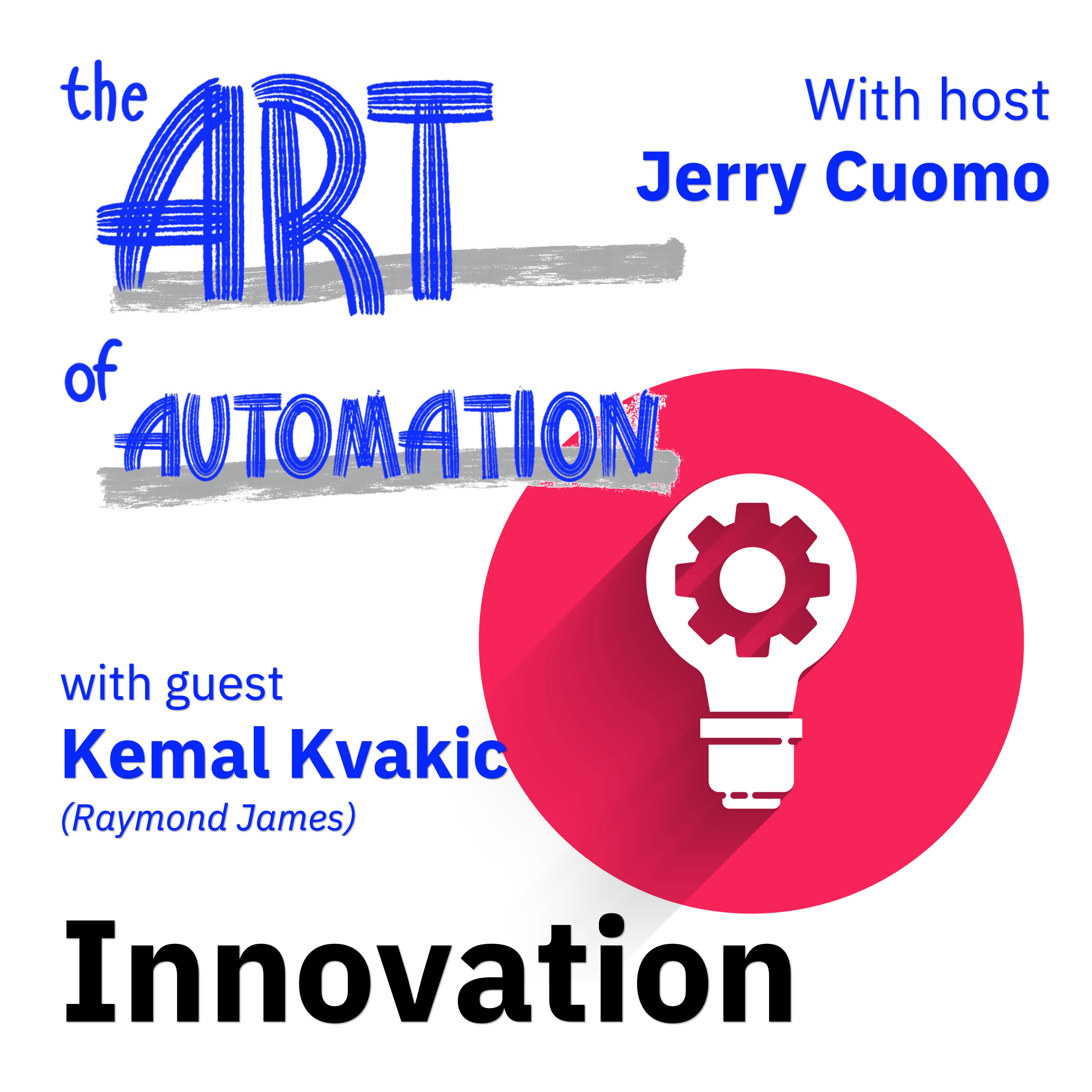Innovation
- 0.5
- 1
- 1.25
- 1.5
- 1.75
- 2
Speaker 1: You are listening to The Art of Automation podcast with your host, Jerry Cuomo.
Jerry Cuomo: Thank you, DJ, and welcome, everyone, to The Art of Automation, a podcast that explores the application of automation in the enterprise. Folks, today's episode is about innovation. Innovation can take many forms, from incremental improvements to radical breakthroughs. Often requires creativity, curiosity, and a willingness to take risks. Successful iterators are not afraid to fail and are willing to experiment and iterate until they find a solution that works. And today, we are fortunate to have our guest, who is the Head of Innovation from Raymond James, Kemal Kvakic, who, in this host's opinion, is the perfect personification of innovation and in particular how you innovate in a modern enterprise, of course with generous amounts of AI and automation. And with that, I'd like to welcome Kemal to The Art of Automation. Welcome, Kemal.
Kemal Kvakic: Oh, thank you. Thank you for having me, Jerry.
Jerry Cuomo: Oh, it is our pleasure. So let's jump right in. Kemal, tell us why you love doing what you do.
Kemal Kvakic: To me, it's all about making a difference. And no matter what I do, it's all about moving forward, learning, making a change, and at the end it's those results of whatever I just said right now, are the things that really get me out of the bed every morning. Now, let's face it, I mean, I do have a dream job. I get fairly unique opportunity to play with the latest technology, explore that technology, assess it, look at the maturity, and at the end look at to see if we should be investing in that. Then I also get this opportunity to give rest of my IT associates opportunity to do the same, get them to play with it some more and then maybe implement it and see how this technology could potentially be used to help our business grow.
Jerry Cuomo: Tell us a little bit more about your job, your role, your title, your company. Just give us a quick overview.
Kemal Kvakic: Yeah. So I'm the IT Head of Innovation for Raymond James Financial. I've been with the company for over five years now and my responsibility is innovation. I mean, I was brought in here five years ago to stand up their robotic process automation, which we've been having for over five years now. As about a year and a half ago, I was named the IT Head of Innovation to do what I just said earlier, is to look ahead, to look at emerging technologies and trends. I mean, I officially say that I'm responsible in building and implementing innovation strategy for the firm and for the IT specifically. But with that it's a reflection of helping the business partners to grow and be more competitive. And so I'm in heart a nerd. I always say that I've been in technology for over 20 years. I'm the USF alum, which is University of South Florida, and I have computer science and computer engineering degree. So I love development, I love technology. So this is a dream job for me.
Jerry Cuomo: What a time to be a chief innovation officer and a nerd in a great company like Raymond James in a time where automation and AI are just running rampant across our industry in a good way.
Kemal Kvakic: It is.
Jerry Cuomo: So can you tell us a little bit more, what are the things that have caught your attention of late?
Kemal Kvakic: I think it's this fast- paced technology that just keeps happening, and we see a lot emerging tech and it excites me to kind of see where this technology can be used across our firm, across the IT and see where we can leverage it, how we can use it, how we can implement it in existing processes, products, services. There's a lot that's happening. I mean, it's honestly a good time to be in technology sector, for sure.
Jerry Cuomo: So tell us a little bit more. So you are a innovators innovator and you happen to be doing that in a financial services company. Can you just share with our audience a little bit about how you affect change, and specifically are there any nuances in affecting technology and innovation change in a financial services company like Raymond James?
Kemal Kvakic: So to me, changes tends to be sometimes hard and especially in a company that has been around for a while. To me, change means changing the minds and mindset of people that have done certain things certain way for a very long time and now we are coming here and asking them to think or do things differently. In my current role, I do get a privilege to work with both business and IT to build the relationships and to better understand both business needs and to see how we can help our business partners also help them understand our technologies and trends and what's available today. Because they're not technical. They know that they need something, but we need to be able to articulate this in terms that they can understand. They're very anxious to figure out if they hear something on a horizon, they really know what's our stance, what are we doing? Are we even looking at this? And if we are looking at it, why are we not moving faster or why are we not implementing this? So that's really kind of one side of it. And then from the IT side of it, it's enablement and encouragement of an IT associate to be more creative, to think outside the box and, of course, to be innovative. I always say, it's one thing to have a technology and it's great, it's great technology, but how can we now use that technology to be used and to help our business partners? And so it's these use cases. So working with business partners to say, " Here's this technology, what do you think where I could apply this technology?" And then at the end of the day, we then leverage our IT associates. Innovation culture is a big pillar of this program. And so we leverage our IT associates to feel them included in the program. So that was an early on decision on our side was when we were setting up this program, do we hire a research and development team, or do we utilize our existing resources, our IT, to be part of the innovation? And we went with the latter because we've early on identified that Raymond James has been innovative for a very long time and it just needed a little tweaking to make that even better.
Jerry Cuomo: So head of innovation involves being a technology nerd, understanding the technology, but being the Rosetta Stone to translate it into all languages, it sounds like. Business languages, IT languages. But also it sounds like there was a tone of being head of innovation involves being a cheerleader too to inspire, to kind of root people on, get them excited and then you used the term the culture of innovation as a way to hang it all together.
Kemal Kvakic: Yeah, it's interesting you say cheerleader. I used the word exactly verbatim. I said, " I'm a cheerleader of innovation," and my team said, " Not really. You're like a facilitator of innovation." So yes, it really takes that, right? I mean, as I said, innovation culture has been a big part of what we do. There's a lot of things that we've done in year or so. One of the big things is what we call innovation insights, where we bring non RJ experts to Raymond James to educate both business and IT on emerging technology, be it quantum computing, Web3, AI, natural language processing, NLP, NLQ. And then we also look at to see if it's a technology that we already onboarded, let's say it's AI, then we bring IT associates that are responsible for that technology to co- host those webinars and those sessions that we have very positive feedback, but it's all in realm of continued education. So the rest of the associates feel included in innovation program.
Jerry Cuomo: Perfect. And I want to stay on that technology trend point. And this is The Art of Automation. So can you talk a little bit about the role of automation and where do you see it making the most impact in your company?
Kemal Kvakic: Yeah, so it's interesting, when we started our automation, I mentioned earlier, about five years ago, and we've automated about 40 large processes. But then when I go on these webinars and when I kind of listen to others, there's a lot of companies that haven't even started in this space, but yet there's so much interest and even now they see a lot of value in implementing this technology. So to us, I mean, as I said, we've started about five years ago and we've automated across different business verticals including the IT, of course IT uses automation as a tool. So I'll give you a generic answer to your question when it comes to what is it that I see that is most impactful. I would say picking the right process to automate. If you pick that right process to automate, it will be impactful and it is going to create benefits for your firm. Some, of course, will yield more ROI and some will yield less. If you automate a process that has more people doing it or it's a larger process or it takes a little longer, you have to run it multiple times, it will have more impact. But that really doesn't mean that the smaller automations are not as impactful. Out of the 40 that I said, we did pick fairly large, but some are larger than others. And then some of our, let's say it's a medium process but yields larger ROI because there's added values. For example, looking at SLAs, that's an important factor in automation. Looking at data quality, look at efficiency. I mean, if you have a process that with, let's say, five people, you run it once a day. With a robot, you can run that five times a day. So of course you include that efficiency part of it. And with efficiency, it's customer satisfaction as well because if somebody's looking at a process, say they do it once a day, but now we process that five times a day, of course customers are going to be happy because they get results quicker. They don't have to wait for a day to get to the insert.
Jerry Cuomo: Especially if the results are less error- prone. And that's really where frustration could build in a customer. Getting that repetitive work done through a robot seems like multiple sides of benefits.
Kemal Kvakic: Yes, yes. Absolutely. And to us, as I mentioned earlier, I mean, we have processes where to us it's more hiring avoidance because I know that's a big deal and I know your listener will probably want to hear about this as well, but to us in five years we haven't had where jobs are lost because of automation. I think it was more a value- add. When we pick a good process to automate, to us it was the automation that people were doing. Now they're doing more thought- provoking work while in meantime the automation does this mundane old boring work that they were doing in past. To me, I would say in this realm of what makes it most impactful, I would say one advice that I can have for your listeners is this. What's really important is to make automation very successful, of course it's one to pick a right automation. Not everything should be automated just because I want to automate. But it's also to ensure that you have proper governance in place to figure out who all can automate, should automate, and against which applications you should be automating. Because to me, and if you don't know how to do that, I would say partner with companies like IBM or whatever those companies are if you don't know how to do it, because they have expertise. To me, here's what I'm going to say. Automation creates dependencies. I know we've learned this over time, but we tried, we have this analogy called crawl, walk, run. We didn't want to get ourselves in a situation where we have ton and ton of these automations that are running against our what we call level one or level two applications. And then let's say that application changes out of nowhere. Guess what? You then have these dependencies. That's what I said, automation creates these dependence. Then you have this dependency where you're like, " Well, wait, that change, that selector that you added, it's no longer username. It's user_name. Oh, wow. Now I have to update 50 different robots that the team has built." And so you get at that point, your maintenance becomes the biggest challenge when it comes to automation. But that shouldn't be a hurdle as well, right? With proper governance, you could control that. There's a lot of tools that you could potentially use. At Raymond James we use ServiceNow. ServiceNow has dependencies built behind the scenes. So when a product, A, makes a change, there's a change request that gets created. That change request alerts all of the automation owners that says, " Hey, in about three months from now, I'll be making this change and be ready for you to make that change in that time period and test it out and go along with me in that journey going to production." So do pick the right process, but here's another, just a quick thought on this. If you don't pick it, that's fine. We've been here as well in our journey. If you didn't pick the right process, guess what? Retire it. It's okay. But as long as you learn from it and you say, okay, now over time as you mature your program, you're going to mature your knowledge about what it constitutes to be a good automation candidates and to end, it'll be a good story. And we all have experienced that here at Raymond James as well.
Jerry Cuomo: Good. And I think that's some great advice. So the first time we met, it was only minutes before we both had our crystal balls out and we were thinking about how certain emerging technologies were going to impact the future of our businesses. Can you share with the audience your views on perhaps what are the top two technology trends that have captured your interest of late?
Kemal Kvakic: The timing is perfect that we are talking about emerging technologies and trends. And I joke around every time somebody asks me to say, " Hey, what's your prediction here?" And I said, just today, we actually had a really good discussion around not that long ago, we thought Metaverse was it. It was buzzing. Everybody was talking about these use cases. We had vendors knocking on our door with, " We can partner with you, we can do these things." And about four months ago something big happened, which is this thing called ChatGPT. It turned our world upside down. It looked at the generative AI in a different lens. It became a mainstream. A lot of people started getting familiar. And at least at that stage it was more like aha moment for many to say there's a lot more that this technology can offer. So to me, I would say first one is generative AI. A ChatGPT, it's on its own little space. But I wouldn't just say ChatGPT. I will call, for example, GitHub Copilot or the Microsoft 365 Copilot that they just recently announced. To me, generative AI technology provides the efficiency. And I do foresee in the very near future that we are going to have tools available to us that utilizes some form of ChatGPT or generative AI that will be almost like a personal assistant to us. I feel quality of our output will be on point. Code commenting, we are GitHub Copilot.
Jerry Cuomo: Does it have to be perfect?
Kemal Kvakic: Technology itself, no. Actually, matter of fact, I was-
Jerry Cuomo: To get value.
Kemal Kvakic: It really depends on, again, is what mindset do you have when you use it. I think for Raymond James, at least we still have ChatGPT as an available tool for us and we made it very clear to say, " Just be smart when you use it. Follow our guidelines, but also don't trust it. It's not end- to- end source yet for the truth." I call it the writer's block. I mean, if I want to write an email and I'm kind of stuck a little bit on how to write an email, guess what? I can get a little bit of a help from ChatGPT. Get the foundation on what I really try to say and then tweak that around and make it my own. The reality here is just that the trust is going to be a big factor. Bias point of it will be a big factor. And we'll see what the future is going to do with this.
Jerry Cuomo: So where do you think it can be applied in financial services and what sorts of returns? Is it faster delivery, less errors, more innovation? Where do you see this landing in the near future?
Kemal Kvakic: There really is, and that's one of the reasons we haven't yet fully made a decision to say, and we are, by the way, monitoring these decisions on regular frequency to say, is there any point in near future where we're going to say it's too risky? So that assessment is being done and we are not there yet. But the value that we see out of it is that, as I mentioned too earlier, innovation, innovation culture is a big part of it. Partnership with our business is extremely important to me and to IT in general. And so as we meet with them, we ask them, " Do you use ChatGPT, and what are some of the use cases you use it?" There's a lot of news, you probably heard news in my sector where some big companies are using ChatGPT. I would say, feedback, at least we've gotten, and our innovation champions here at Raymond James, which are set of IT associates, 12 or so, that we meet on regular basis and talk about innovation, one of the big things is knowledge summation, because you know that ChatGPT takes 10 different documents and understands those documents and provides you a human- like response. So we do have a lot of content on our internal knowledge systems. We have a lot of procedures that are written on PDF formats and PDF documents. I think one of the good use cases that we want to explore further is to say, " How can we read all of that content and make it in such way that somebody can search on our website and get a human- like response," instead of right now, the way it is is you search for a keyword, you get this 50 page document, then you got to read that document itself to find the answer inside the document. So it becomes time- consuming. So I think to your answer specifically, it's more about time and time efficiency, because again, I think generative AI is all about efficiency. So less time I need to spend to find an answer in a document, more time I have to spend with my clients, because that's the ultimate goal is spend less time on technology, more time with your clients. That's our direction and that's our goal. And having ChatGPT or generative AI and create that efficiency where we can get answers quicker, that's something we are striving for and definitely looking in this technology to see if we can explore it further.
Jerry Cuomo: Well, this is perfect. Yeah, this is perfect. Thank you so much for joining us on The Art of Automation. As heads of innovation go, I can't imagine another one out there with your energy, with your ability to inspire folks. So thank you so much for joining us.
Kemal Kvakic: Thank you, Jerry.
Jerry Cuomo: Okay, folks, that's it for today, and if you enjoyed this podcast, it's also likely that you'll enjoy The Art of Automation book, which is now available. A link to the book is available in the description section of this podcast. And royalties for The Art of Automation book are being donated to help support cancer research. Once again, I'd like to thank Kemal, and of course, I'd also like to thank you all for listening in. This is Jerry Cuomo, IBM Fellow and VP for Technology at IBM. See you again on an upcoming episode.
DESCRIPTION
Welcome to the latest episode of the Art of Automation podcast, where we explore the latest trends and insights on innovation and automation. In this episode, our host Jerry Cuomo sits down with Kemal Kvakic, Head of Innovation at Raymond James, to discuss the role of innovation in a modern enterprise.
Kemal shares his passion for innovation and sheds light on his role at Raymond James. As Chief Innovation Officer, Kemal discusses how he drives change within the organization, including business sponsorship and partnering with IT.
The conversation then turns to the role of automation in financial services, and Kemal provides insights into where he sees the most impact. He also discusses his top technology trends of interest - generational AI and ChatGPT in financial services - and what he believes their impact will be in the future of financial services.
Tune in to this episode of the Art of Automation podcast to hear from an industry expert on the latest trends and insights on innovation and automation in financial services.
Key Takeaways:
- [04:37 - 06:48] Nuances in affections technology and innovation change in financial services
- [08:30 - 10:27] The role of automation, and where it can be impactful at Raymond James
- [14:06 - 16:26] Kemal shares his top two tech trends
- [16:40 - 18:51] Innovation culture
Today's Host

Jerry Cuomo
Today's Guests








